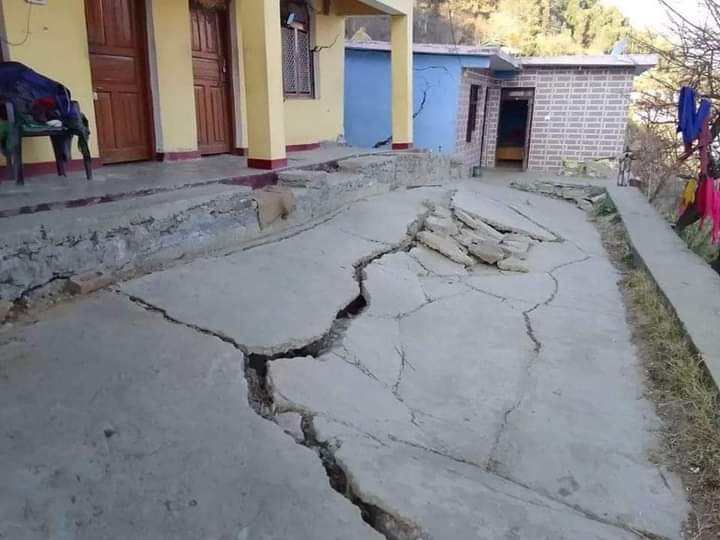
 By Kaushal Kishore*
By Kaushal Kishore*
The aquifer bursts beneath the Jaypee Colony of Joshimath in the Himalayas on January 2, 2023. A series of disturbing news is coming about the rapid ground subsidence since then. It has initiated and continued to frighten everyone. The sinking of the ground at an altitude of over six thousand feet is sufficient to remind the missing lights of the ancient shrines of Adi Shankara and the capital of Katyuri Kingdom that redefined Indian knowledge traditions on the silk route.
Today, all eyes are fixed on Joshimath watching what unfolds in the heartland of the Himalayas. The Prime Minister interpreted its seriousness to the Chief Minister of Uttarakhand. From New Delhi to Dehradun to Chamoli, all are aligned to ratify the PM, CM and DM (District Magistrate) alignment of the statecraft and its colonial hangover.
Local people are on the streets with the slogan “NTPC Go Back!” Some others are asking about the compensation—in terms of nothing less than the Badrinath corridor project. Bureaucracy is busy. In addition to evacuation, they have procured 4000 prefabricated houses for safe shelters. At last, the apex court has started hearing the public interest litigation only today, the newest Shankaracharya of Jyotirmath has played a key role in the petition. Initially, the Supreme Court of India declined an urgent hearing in this case and allowed the executive to act freely for the survival of life in the Joshimath area.
Meanwhile, the Prime Minister’s Office declared it a landslide subsidence zone and asked the experts to prepare short and long-term plans to improve the situation. The expert committee will share its findings after their study. Thereafter the NDMA (National Disaster Management Authority) advised government agencies to refrain from making comments on the subsidence.
The tunnelling associated with NTPC (National Thermal Power Corporation) and its 520 mega-watt TVHP (Tapovan Vishnugad Hydropower Project) is next to Joshimath. The administrative officers of the State have served notice to stop the construction works at that site. But the foot soldiers of the ruling class refused to obey and denied any responsibility for the destruction of Joshimath. Two governments—the Centre and the State—are ready to accept it. The same reflects a response to the Uttarakhand government from the Union Power Ministry. The consultation with the Union Home Ministry on it is in progress. It suggests that the NTPC tunnel is not passing under the town of Joshimath, and the main causes of subsidence are the sub-surface seepage and erosion by natural drainage, the occasional heavy rainfall, seismic activities and heavy construction works.
Also read:
- जोशीमठ के भूधंसाव पर शंकराचार्य ने सर्वोच्च न्यायालय में दस्तक दी
- PMO calls for risk-sensitive urban development plan for Joshimath
- दो-टूक: नहीं बचेगा हिमालय
- क्या हैं जोशीमठ आपदा के कारण?
- जोशीमठ स्थित आदि शंकराचार्य के तपोस्थली ज्योतिर्मठ में भी दरार पड़ा
- कविता: ये चीख है पुकार है पहाड़ की गुहार है
- जोशीमठ की त्रासदी
- जोशीमठ में भूधंसाव से जूझते लोग
Now equation between the ruling class and the political class is in the public. The foot soldiers of the political class are divided into two different lines whether asking for compensation or no more old and new development projects. The proponents of modern development vision are ready to suggest how to save the town, but no one seems to care about them.
Jyotirmath hosts experts like Ravi Chopra and activists like Atul Sati to depict the true picture. Here public joined together for the Joshimath Bachao Sangharsh Samiti (JBSS) with the spirit of cooperation and coordination. Meanwhile, ground subsidence is recorded around the badminton court in Jaypee Colony to be 70 centimetres, on the other place it’s 7-10 centimetres. More than a hundred victims are in shelter homes and thousands are expected to increase further. This crisis is not limited to the Himalayan State of Uttarakhand alone. Jharauta, the little village in the Chamba district of Himachal Pradesh is 400 kilometres apart from Shimla. Its population of two hundred people are yet another victim of the tunnels, hydropower projects and modern development vision. Bhutanese journalist and environmentalist Dawa Gyelmo and others have been reporting extensively on the cracks and the compensation paid by companies responsible for the same. In the Himalayan state of Uttarakhand, there are several other towns like Karnaprayag and Nainital, in addition to more than five hundred villages. Pipelines of smart city projects have caused a series of cracks in the Aligarh and Baghpat districts of Uttar Pradesh, and certain ghats of Banaras are also witnessing cracks, ground sinking and associated problems that can widen the scope of impending danger.
The thermal power corporation was conceived to generate coal-powered electricity in India. They are not trying to explore thermal power, but hydropower in the Himalayan valley. The political economy of this project seems to be as dark as coal. The Kedarnath flash flood of 2013 and the Rishi Ganga flash flood of 2021 are also parts of this debate. The experts presented a couple of other incidences before the new aquifer burst. In 2009, as a result of the accident, a tunnel boring machine punctured a natural aquifer. The same has been repeated again. After the flash flood on February 7, 2021, the local people started to witness certain cracks in houses and fields. The expert committee is required to conduct a time-consuming study to verify the claims of activists and experts involved in the conservation of the ancient town for several years.
The shrine is built on the debris of a landslide. As such, an incredibly fragile region has been destined for its destructive fate. Joshimath is also referred to as Yoshika and Yoshi in the scriptures. It refers to a gateway to two shrines – Kailash Mansarover and Badrinath. Mana and Niti are the two villages connecting us to the Tibetan plateau. The shrine is also associated with a myth that predicts its doomsday. One day I came to know about it during my pilgrimage to Joshimath in the last week of September 1997. The priest of Shri Narsingh Mandir described it to predict the fate of this region and the seat of Badrinath in future. Cultural wisdom and its lights are nowhere in the prevailing darkness between two different phases of history. Even after the perpetual knowledge of the dooms day the town is destined to be the same. Both of the knowledge traditions have failed to address the prevailing crisis.
The rising Himalayas cannot be compared to the Aravalis or the Alps in Europe. The third pole has been boiling in the freezing cold winter since the beginning of this year. Mirabehn (Madeline Slade) wrote, Something Wrong in the Himalayas. Almost a decade after the Sino-India war erupted to define the colonial hangover in 1962, and since then onwards the geopolitical realities have been haunting this part of the globe. The spirit of the Chipko movement, in the mid-seventies, defined Gaura Devi and her village Reni. A few days before rapid subsidence Reni’s new generations interacted with Pushkar Singh Dhami, Chief Minister of Uttarakhand and failed to get the attention required to address this crisis. However he has visited the shrine, the fear of an earthquake is still there reminding the fading lights between Joshimath and Jyotirmath.
*Author of The Holy Ganga (Rupa 2008) and Honourary Secretary, Srishti Sustainable Development Foundation.





